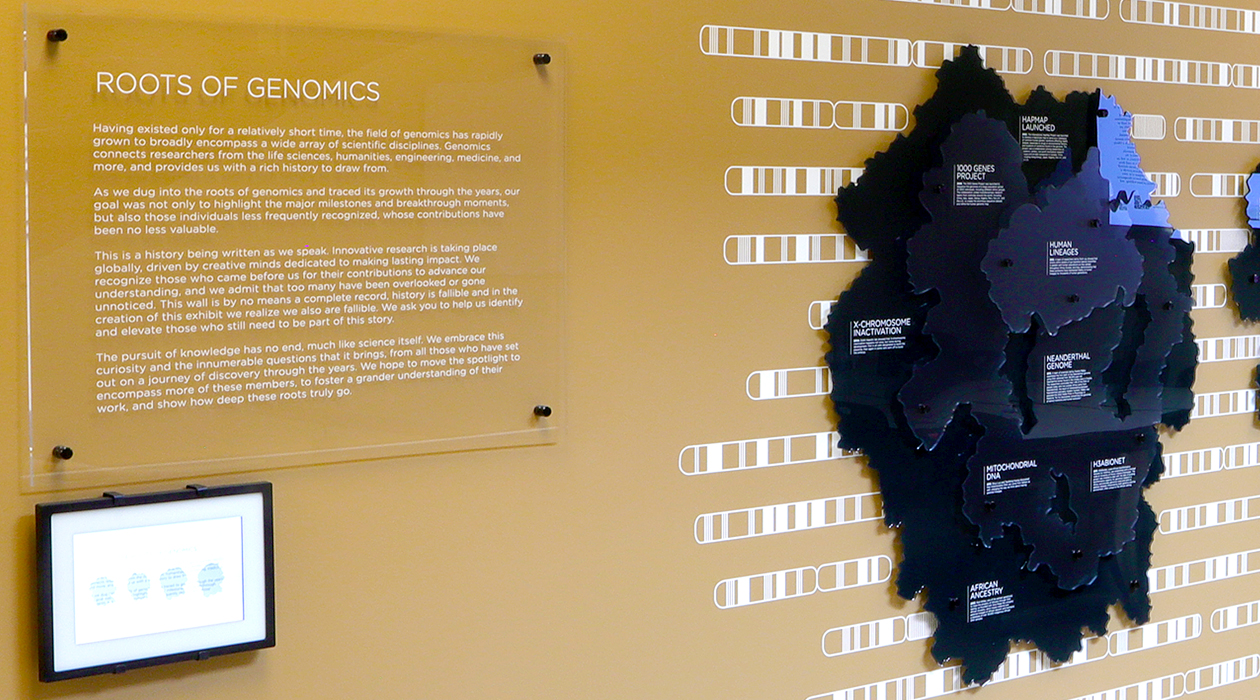'Roots of Genomics' installation celebrates the diverse history within the field of genomics

The Roots of Genomics installation highlights moments from the history of the field of genomics, with efforts towards promoting the contributions of historically underserved individuals. / Isaac Mitchell
Explore the rich history of genomics in the latest installation inside the Carl R. Woese Institute for Genomic Biology, titled ‘Roots of Genomics’. This new artwork beckons visitors to peruse significant milestones and achievements that have shaped the field of genomics.
Located on the concourse floor of the IGB Gatehouse, the installation features plexiglass ribosomal shapes mounted onto metal standoffs, creating a captivating three-dimensional effect. Each ribosome is etched with key events in genomics history, set against a backdrop of human chromosomes artfully arranged to resemble a karyotype.
The piece serves as an inclusive timeline, highlighting not only the well-documented history of genomics but also the contributions of underrepresented scientists whose work has often been overlooked.
“The IGB DEI Task Force proposed the idea to create an installation that spoke to the unsung voices within the history of science” said Nicholas Vasi, the IGB’s Executive Director of Communications and Engagement. “We decided to focus on the history of genomics specifically, as it is core to the IGB, and is a manageable timeframe since the field only originated in the early 70s. It’s a young enough field that we were able to talk with people that were around when these concepts were emerging, and really dig into the history.”
Julia Pollack, the IGB’s Creative Program Manager, brought the idea to life after being inspired by an article describing how life began, and the key role ribosomes played in this development. The article included a figure of the structure of a ribosome, highlighting the innermost and oldest part nestled in the middle. This inner structure, where amino acids click together to form complex proteins, is nearly identical across vastly different organisms, suggesting its essential role in life.
“I was inspired by the ribosome, and felt it really spoke to our institution,” said Pollack. “Carl Woese discovered the third domain of life through sequencing ribosomes, and ribosomes are also an important and ancient mechanism that all living things throughout time have in common. That’s why I decided to use the shape of ribosome to capture the content of our timeline.”
With this vision in mind, the IGB communications and outreach teams, faculty, and DEI Task Force collaborated to meticulously sift through the history of genomics. They identified influential moments in the field, giving special attention to those often omitted from mainstream history.
Important events and research findings were distilled into short, digestible facts, organized into the categories based on the domains of life, and represented on different ribosome-shaped pieces. After the design was completed, the IGB facilities team worked to expertly assemble the installation. Pollack emphasized that the timeline’s design was intended to be a collection of intriguing snippets rather than a standard, rigid timeline, to encourage both casual browsing and in-depth exploration.
“We wanted to create a timeline of genomics that people could engage with, that invited them in to read small manageable pieces of information without having to read an entire ordered list,” explained Pollack. “The design is meant to be something you can casually browse and let your eyes wander over. You can easily jump in and out of topics and periods in time that interest you, and walk away having gotten something meaningful out of it.”
Pollack, who is also the current curator for Art of Science, a long-standing IGB program that merges science and art, noted the distinct differences between creating the Roots of Genomics wall and her previous AOS pieces.
“It was cool to get to design something for a specific space. AOS pieces are designed for a standardized poster format that makes them durable and able to be put up in all kinds of public locations,” said Pollack. “This installation was intended for a specific wall, so I had to draw and design it with that in mind. People often walk by this spot on tours, or on their way to and from the café, and when walking between the buildings; it’s a central location. This is why I designed it be approachable and easy to pull out interesting bits of history from.”
Viewers of the installation will also find an invitation within the text on the wall, encouraging them to share information on individuals or events that may have been overlooked. These contributions will be displayed on a digital screen next to the installation, which will be continually updated.
“This piece is an incomplete history; we know there are people and events we have overlooked that we are still discovering,” explained Vasi. “With the addition of the screen, not only are we going to be able to keep unearthing things from the past, but we will be able to add things as history keeps moving forward with new discoveries. The physical piece may be permanent, but the screen provides for a more ephemeral side, allowing it to be easily updated as we uncover more.”
The ‘Roots of Genomics’ installation not only honors the past but also invites ongoing engagement and discovery, ensuring that the vibrant history of genomics continues to inspire, and to evolve.
